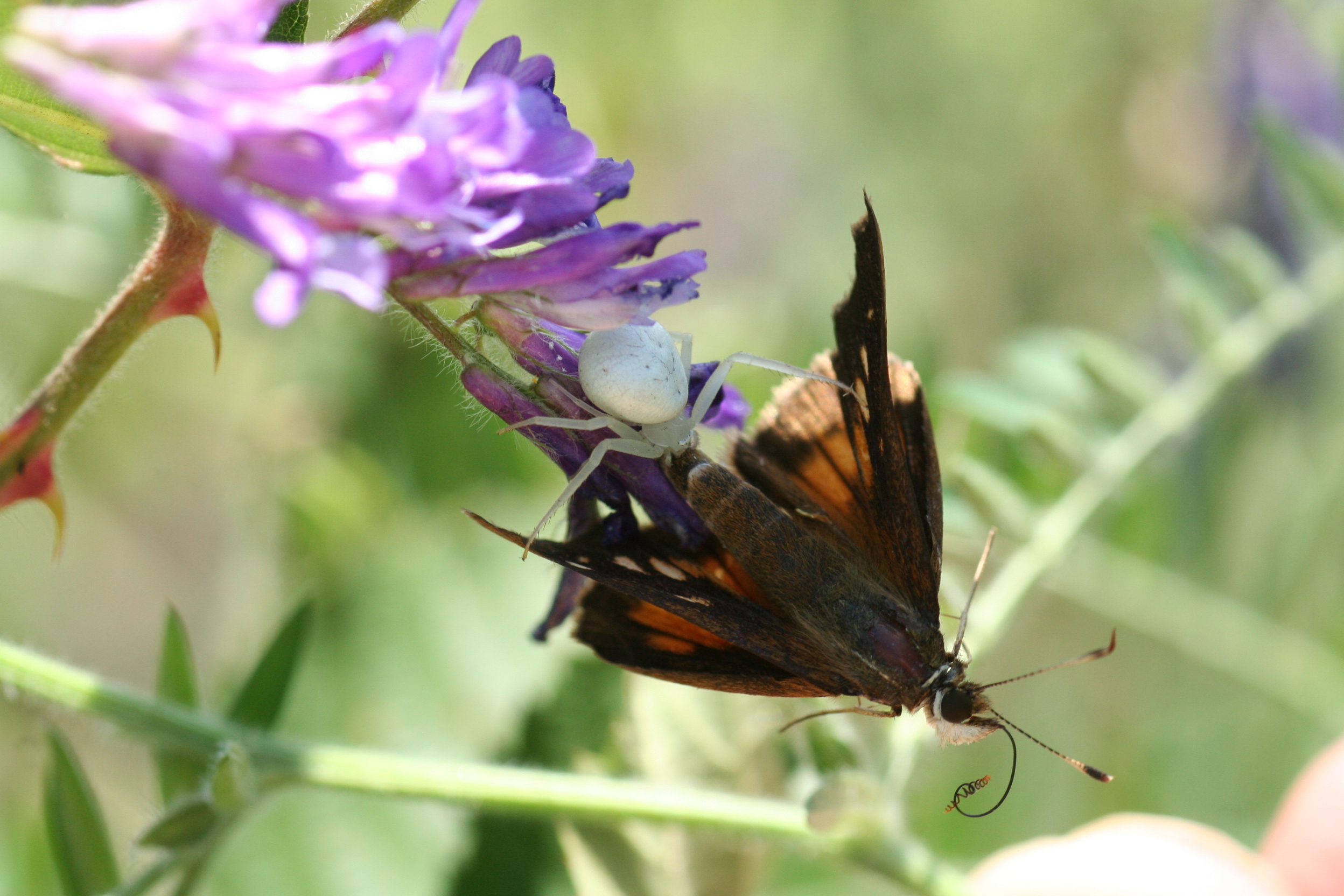
Coral hairstreaks in tandem along the Atlantic Ave powerline in Egg Harbor Township (Atlantic Co) on June 23.
June 30 is not quite halfway through the butterflyer’s year, so it’s too early for any final conclusions for 2011. Still, it’s tempting to feel bullish.
Last year, 2010, seemed very-good-to-excellent to most South Jersey butterflyers (and North Jersey observers as well), and at the moment, our results of 2011 seem even a little ahead of last year’s run.
An unsolved question: how should we factor observer effort and skills? Are we recording more butterflies simply because we have more observers out in the field for more hours (and we are growing steadily more knowledgeable each year)? Or, are there simply more butterflies flying this year than last?
Even without counting the two June NABA Counts at Belleplain and Cumberland (that data should be added shortly), June 2011 ran slightly ahead of June 2010. In short-hand form:
June 2010: 56 species in 1276 reports of 9313 individuals butterflies
June 2011: 59 species in 1900 reports of 12075 individual butterflies.
Species seen in adult form in June, 2011, with FOYs in italics:
4 swallowtails: pipevine, black, tiger, and spicebush.
3 pierids: cabbage white, clouded sulfur, and orange sulfur.
14 lycaenids: American copper, bog copper, coral hairstreak, Edward’s hairstreak, banded hairstreak, striped hairstreak, frosted elfin, eastern pine elfin, juniper/Hessel’s hairstreak (sp), white-m hairstreak, gray hairstreak, red-banded hairstreak, eastern tailed-blue, and summer azure.
19 nymphalids: American snout, variegated fritillary, great spangled fritillary, pearl crescent, question mark, eastern comma, mourning cloak, American lady, red admiral, common buckeye, red-spotted purple, viceroy, hackberry emperor, tawny emperor, Appalachian brown, Georgia satyr, little wood-satyr, common wood nymph, and monarch.
29 hesperids: silver-spotted skipper, southern cloudywing, northern cloudywing, Hayhurst’s scallopwing, Juvenal’s duskywing, Horace’s duskywing, wild indigo duskwing, common checkered skipper, common sootywing, least skipper, swarthy skipper, European skipper, fiery skipper, dotted skipper, Peck’s skipper, tawny-edged skipper, crossline skipper, northern broken dash, little glassywing, sachem, Delaware skipper, rare skipper, mulberry wing, zabulon skipper, Aaron’s skipper, broad-winged skipper, two-spotted skipper, dun skipper, and saltmarsh skipper.
The last FOY for June was great spangled fritillary recorded on June 29 by Sandra Keller at National Lands Trust Property in Salem. That gave us 82 species for the year (and on July 2 we added meadow fritillary for #83; see post below).
In June last year we found only two species we did not record in June this year: oak hairstreak and painted lady. (It has not been a good year for V. cardui so far, with only two reports for 2011, one in late April and the other in early May.)
We found five species this June not recorded in June 2010: frosted elfin, eastern pine elfin, Juvenal’s duskywing, mulberry wing, and fiery skipper.

Mulberry wings were found on their best-known colony on the Tuckahoe River on the border of Atlantic and Cape May Counties. Photo by Will Kerling, 6/19/11
The five most-reported species for June 2011: cabbage white (210 June reports), spicebush swallowtail (137 reports), orange sulphur (117 reports), eastern-tailed blue (117 reports), and common buckeye (111 reports). Species recorded only once during the month: frosted elfin, eastern pine elfin, great spangled fritillary, Georgia (NJ) satyr, Hayhurst’s scallopwing, Juvenal’s duskywing, European skipper, and fiery skipper.
Hairstreak numbers, which have been down since 2009 for most species, especially Satyrium, seem OK/mediocre at the moment, slightly up from last year’s humdrum totals. Juniper hairstreak has been notable in its absence, and we had just one report of a green hairstreak in June, by Ray Sampson who had a brief look of a juniper/Hessel’s at Lakehurst on June 18.
Coral hairstreak numbers seem up from last couple of years, and Edward’s hairstreaks were found reliably at the Hesstown powerline hot spot in Cumberland County.

Edward’s hairstreak, Hesstown powerline, photo by Stephen Mason, 6/26/11
Several observers have been adding caterpillar records on the log. Super! Keep at it, please. We should be charting them for an even better understanding of butterfly ecology in South Jersey, and, of course, they are beautiful too:

Silver-spotted skipper caterpillar photo by Will Kerling, 6/24/11.
So, all in all, it seems like a good year so far, the weather has been cooperating, and July’s butterfly and butterflyer activity has continued in the same spirit as June’s ended. But let’s not take anything for granted, because just when you least expect it…..
A crab spider dispatches a broad-wing on the Cumberland NABA 6/29/11.
Keep alert, everyone! And keep exploring and logging in!
jc
Here’s a pdf of the June spreadsheet. Click on the + to enlarge. You can also find this pdf on the “In-Progress Compilation” page. If you would like it in Excel form, just email me.


That is an amazing capture of coral hairstreaks mating!
How do we factor observer effort and skill? Possibly put another two columns in the spreadsheet? One column can have a rating of observer’s skill, 1-5, 1 being new to the butterfly scene and 5 being experienced. The second column can be how much time spent at a certain site, by hours. This way we may be able to have a little bit of data to start and quantify what we have more precisely.
~Steve
Steve,
Thanks for the idea! I like that second column idea especially: asking observers to note time spent at a spot would certainly add another valuable quantifiable factor to our log.
Let’s see what others think of that. Time in the field is factored into the NABA July 3 Counts, of course.
jc